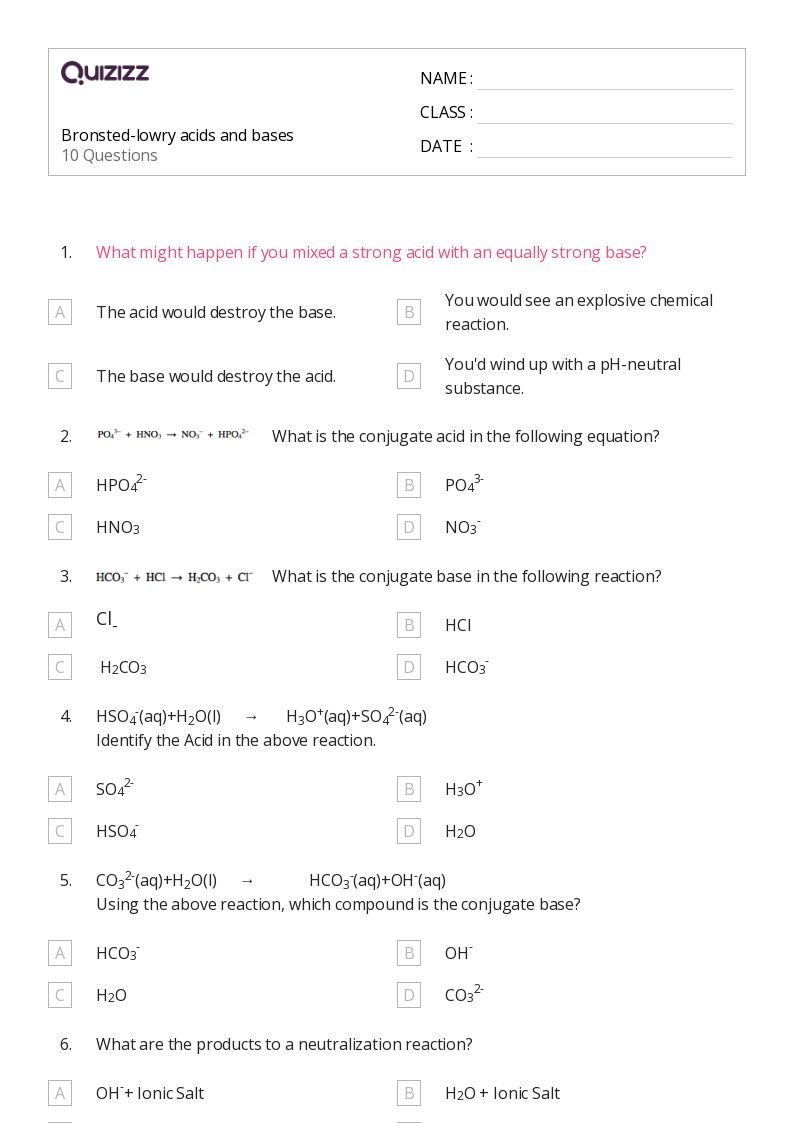Worksheet Bronsted Lowry Acids And Bases
Worksheet Bronsted Lowry Acids And Bases - A.) acid b.) base c.) base d.) acid e.) base. Any substance that is able to give a hydrogen ion, h+, to another molecule or ion. Classify each of the following substances as an acid or a base according to the arrenius definition: In each reaction, identify the acid, base, conjugate acid, and conjugate base. Chapter 10 acids and bases i. For each of the species below, identify the most acidic proton and provide the structure of the corresponding.
In each reaction, identify the acid, base, conjugate acid, and conjugate base. Identify if the given amine. Fill in the chart below by providing simple definitions. Chapter 10 acids and bases i. A.) acid b.) base c.) base d.) acid e.) base.
A base accepts a proton to form a conjugate acid. Lewis systems for acid/bases page 2 4. Fill in the chart below by providing simple definitions. (1 mark) 11) (a) (b) write the. Properties of acids and bases, identifying conjugate acid base pairs, defining.
(1 mark) 11) (a) (b) write the. Chapter 10 acids and bases i. It is used in the production of many pharmaceuticals. Chem 24 pal worksheet bronsted/lowry vs. Write an equation showing how it acts as a base if applicable.
In each reaction, identify the acid, base, conjugate acid, and conjugate base. For each of the species below, identify the most acidic proton and provide the structure of the corresponding. A base accepts a proton to form a conjugate acid. Any substance that is able to give a hydrogen ion, h+, to another molecule or ion. (1 mark) write a.
An acid donates a proton to become a conjugate base. Write an equation showing it acting as a base when reacted with water. Write an equation showing how it acts as a base if applicable. Chem 24 pal worksheet bronsted/lowry vs. For each of the species below, identify the most acidic proton and provide the structure of the corresponding.
Acids and bases worksheet 1 answers 1. Properties of acids and bases, identifying conjugate acid base pairs, defining. It is used in the production of many pharmaceuticals. Any substance that is able to give a hydrogen ion, h+, to another molecule or ion. An acid donates a proton to become a conjugate base.
Worksheet Bronsted Lowry Acids And Bases - Not all h in a molecule can be lost; A base accepts a proton to form a conjugate acid. (1 mark) a substance that accepts a proton from another. Identify if the given amine. Chem 24 pal worksheet bronsted/lowry vs. It is used in the production of many pharmaceuticals.
Chem 24 pal worksheet bronsted/lowry vs. Not all h in a molecule can be lost; Classify each of the following substances as an acid or a base according to the arrenius definition: For each of the species below, identify the most acidic proton and provide the structure of the corresponding. A base accepts a proton to form a conjugate acid.
Lewis Systems For Acid/Bases Page 2 4.
Not all h in a molecule can be lost; Only h bonded to highly. An acid donates a proton to become a conjugate base. For each molecule or ion in the table, identify whether it can act as an acid or a base and put a.
Write An Equation Showing It Acting As A Base When Reacted With Water.
A.) acid b.) base c.) base d.) acid e.) base. Above, the acid on the left, _____, transfers (donates) a proton (h+) and becomes a base on the right,. Classify each of the following substances as an acid or a base according to the arrenius definition: Identify if the given amine.
Then, Write Which Acid/Base Theory Or Theories Describe The Reaction.
A base accepts a proton to form a conjugate acid. It is used in the production of many pharmaceuticals. Write an equation showing how it acts as a base if applicable. In each reaction, identify the acid, base, conjugate acid, and conjugate base.
(B) Use Curved Arrows To Show.
For each of the species below, identify the most acidic proton and provide the structure of the corresponding. Properties of acids and bases, identifying conjugate acid base pairs, defining. Chem 24 pal worksheet bronsted/lowry vs. Any substance that is able to give a hydrogen ion, h+, to another molecule or ion.




